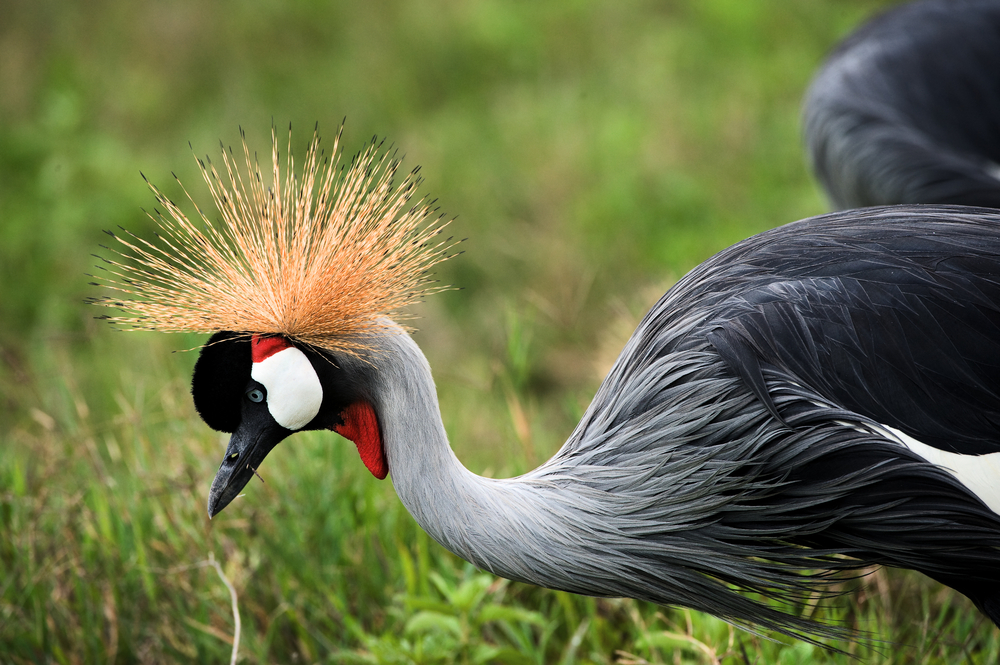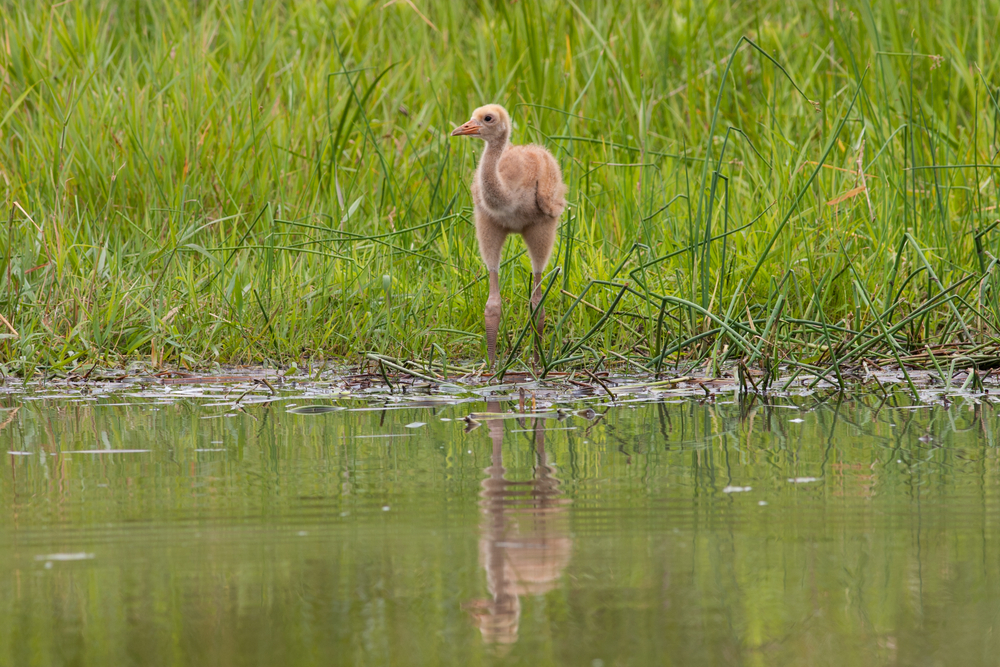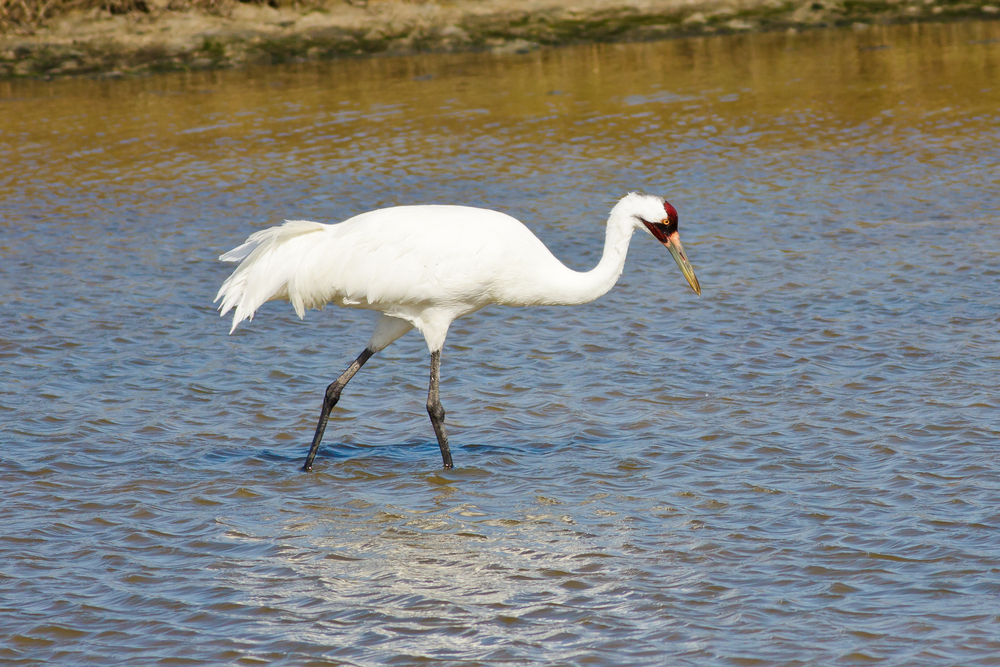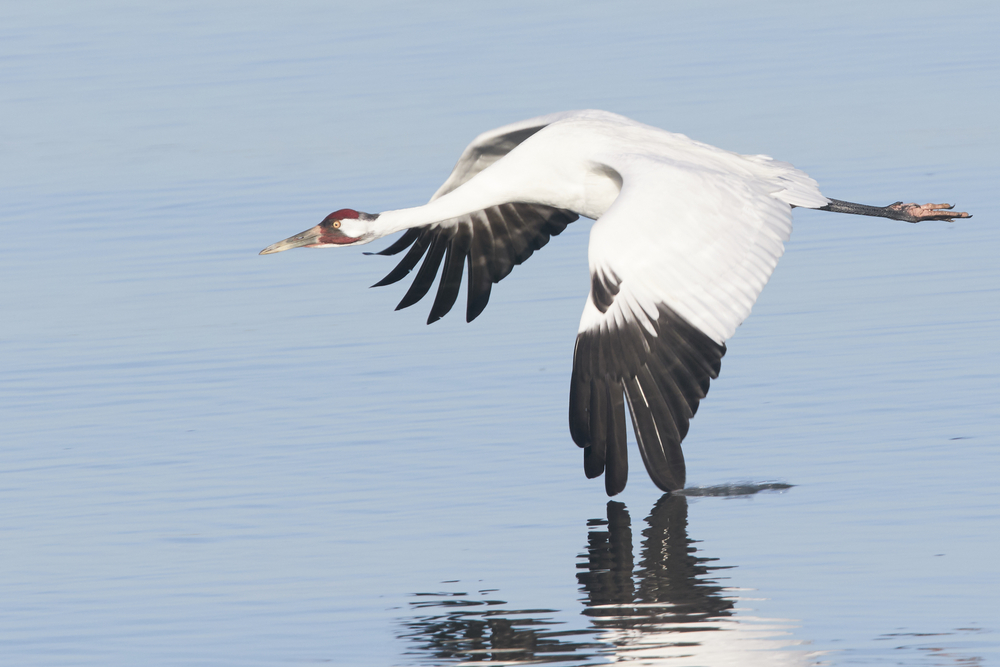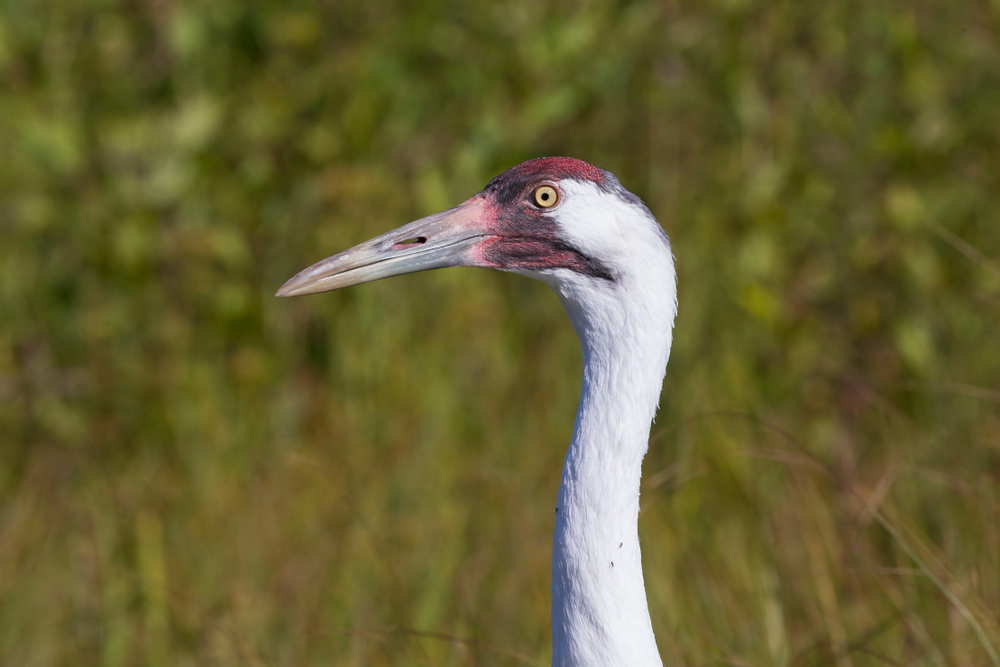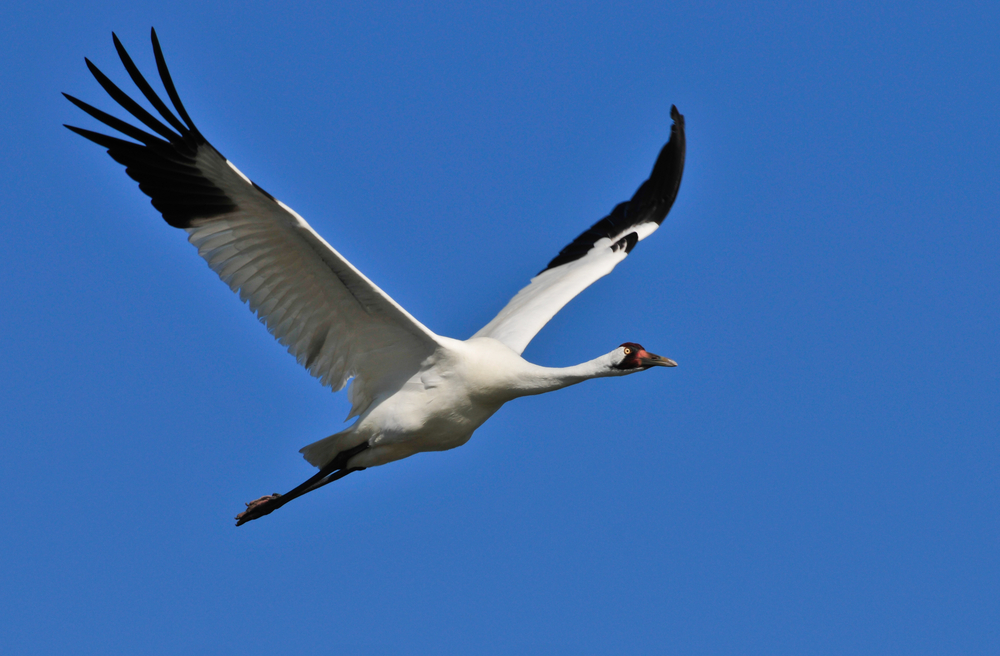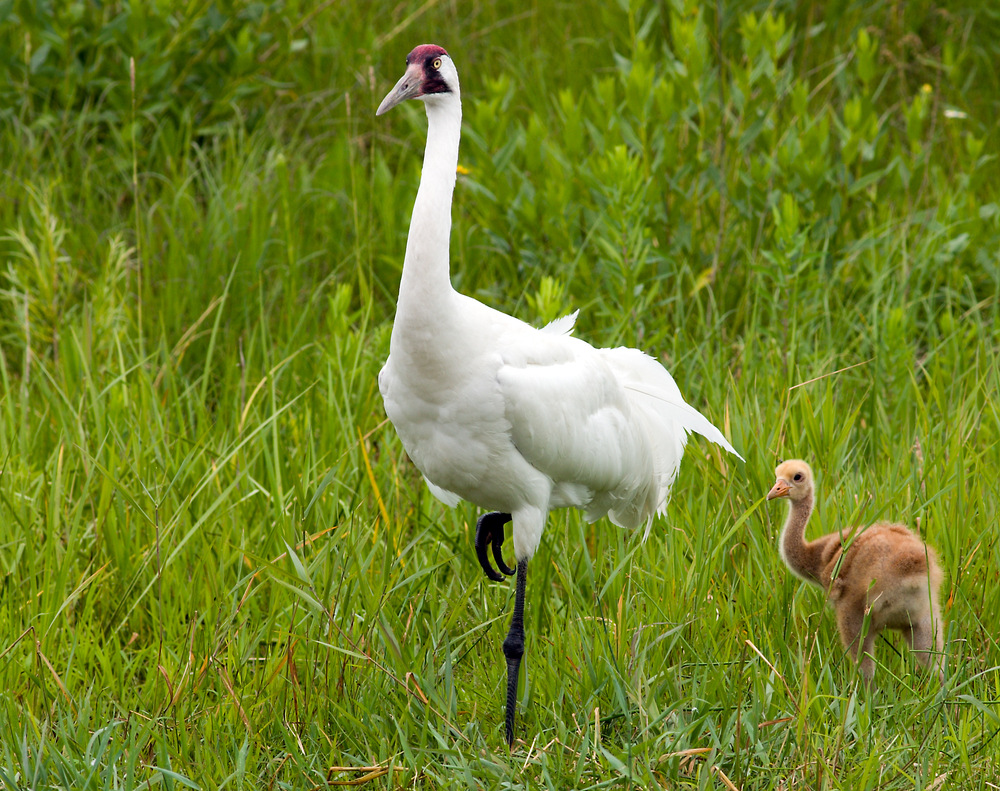About
The Whooping Crane, scientifically known as Grus americana, is a species of crane belonging to the Animal Kingdom’s phylum Chordata and class Aves. It is a member of the Gruidae family, which also includes other large-bodied birds such as the sandhill crane and the common crane. The Whooping Crane is native to North America, specifically the United States and Canada.
This iconic bird is known for its striking appearance, featuring snowy white plumage with black wingtips and a red crown atop its head. It has long legs, a long neck, and a distinctive loud, trumpeting call that echoes across the wetlands where it resides. Whooping Cranes are one of the tallest birds in North America, standing at around five feet tall with a wingspan of over seven feet.
Whooping Cranes primarily inhabit wetlands, marshes, and shallow lakes, where they forage for aquatic plants, small fish, crustaceans, and insects. They are known for their elaborate courtship displays, which involve dancing, calling, and aerial acrobatics. Whooping Cranes are monogamous and often mate for life, with pairs forming strong bonds that last throughout the year.
Conservation Concerns
The Whooping Crane is one of the most endangered bird species in North America, facing significant conservation challenges due to habitat loss, degradation, and human disturbance. Historically, hunting and habitat destruction decimated populations, leading to their near-extinction by the mid-20th century.
Conservation efforts, including habitat restoration, captive breeding programs, and strict protection measures, have helped increase the Whooping Crane population in recent decades. However, the species still faces threats from habitat loss due to agriculture, urban development, and climate change.
The International Union for Conservation of Nature (IUCN) Red List categorizes the Whooping Crane as endangered. Despite conservation efforts, the population remains small and vulnerable, with only a few hundred individuals living in the wild. Continued conservation efforts and habitat protection are crucial for ensuring the long-term survival of this iconic bird species.
Physical Characteristics
The Whooping Crane (Grus americana) is one of the tallest and most majestic North American birds, known for its striking appearance and the distinctive, loud whooping sound it makes. Once on the brink of extinction, concerted conservation efforts have helped its numbers to slowly recover, though it remains endangered. Here’s a detailed look at the physical characteristics of the Whooping Crane:
Size
- Height: Adult Whooping Cranes stand about 5 feet (1.5 meters) tall, making them the tallest North American bird.
- Wingspan: They boast an impressive wingspan of 7 to 8 feet (2.1 to 2.4 meters), which supports their strong and graceful flight.
- Weight: Adults typically weigh between 14 to 17 pounds (6.3 to 7.7 kilograms), with males being slightly larger than females on average.
Physical Characteristics
- Body Shape: Whooping Cranes have a long, slender body, long neck, and long legs, typical of cranes, which aids in their ability to wade through marshy waters in search of food.
- Plumage: Their plumage is predominantly white, with black wingtips that are visible only in flight. The contrast of the black and white feathers during flight displays is striking and beautiful.
- Head: They have a distinctive red patch on the crown and the cheek, which can expand and become more vivid when the bird is excited or alarmed. The rest of the head and the bill are black. The eyes are yellowish.
- Bill: The long, straight bill is adapted for probing into mud and water for food, including crustaceans, small fish, and amphibians.
- Legs and Feet: Their long, black legs and feet are well-suited for their life in marshy wetlands. These long legs allow Whooping Cranes to navigate deep waters while foraging.
Behavior and Adaptations
Whooping Cranes are migratory birds, traveling long distances between their breeding grounds in northern Canada and their wintering habitats along the Gulf Coast of Texas in the United States, and some parts of Florida. They are known for their elaborate courtship dances, which include leaping, flapping, and loud calling. These dances strengthen bonds between mates and are a spectacular sight.
Whooping Cranes mate for life and are highly protective of their nests and young. They typically lay one to two eggs, but usually, only one chick survives due to the high demands of parental care. Their diet is varied and includes insects, crabs, and grains, which they forage in shallow waters or fields.
The Whooping Crane’s stark white plumage, contrasting black wingtips, and red facial patch make it an unforgettable sight, symbolizing the successes and ongoing challenges of wildlife conservation.
Reproduction
As a member of the Gruidae family, the Whooping Crane has a similar reproductive cycle. Here is an overview:
Sexual Maturity:
Whooping cranes typically reach sexual maturity between the ages of 3 to 5 years, although individual variations and environmental factors may influence this timeline.
Breeding Season:
The breeding season for whooping cranes usually occurs in late winter to early spring, typically from February to May, depending on the geographic location of their breeding grounds.
Courtship and Mating Behavior:
Whooping cranes engage in elaborate courtship displays during the breeding season to attract mates. These displays involve dancing, vocalizations, and intricate rituals performed by both males and females.
Pair Bonding:
Once a pair has formed, whooping cranes typically mate for life. They establish strong pair bonds through mutual grooming, synchronized displays, and vocalizations.
Nesting and Egg Laying:
Whooping cranes build their nests in wetland habitats, typically in areas with tall vegetation for camouflage and protection. The female usually lays one or two eggs, with an interval of 1 to 3 days between each egg.
Incubation Period:
Both the male and female take turns incubating the eggs, which lasts approximately 29 to 31 days. During this time, they share the responsibility of keeping the eggs warm and protected.
Hatching and Chick Rearing:
After the eggs hatch, the parents continue to care for the chicks, feeding them regurgitated food and protecting them from predators. The chicks grow rapidly and fledge from the nest after about 80 to 100 days.
Juvenile Development:
Juvenile whooping cranes remain with their parents for several months after fledging, learning essential survival skills such as foraging and navigation. They gradually become independent and may join migratory flocks in the fall.
Reproductive Success:
Reproductive success in whooping cranes is influenced by various factors, including habitat quality, food availability, and the presence of disturbances or threats such as predation and human activities. Conservation efforts focus on protecting critical breeding habitats, managing human activities in these areas, and implementing captive breeding programs to boost population numbers.
Understanding the reproductive cycle of whooping cranes is crucial for conservation efforts aimed at preserving this critically endangered species and ensuring its long-term survival in the wild
Lifespan
The whooping crane (Grus americana) is one of the most iconic and endangered bird species in North America. Known for its distinctive “whooping” call and striking white plumage with black wingtips, the whooping crane is a symbol of conservation efforts to save endangered species from extinction. Understanding its lifespan and the factors influencing it is crucial for its conservation and recovery.
Lifespan in the Wild: In the wild, whooping cranes have an average lifespan of about 20 to 30 years, although some individuals have been known to live longer, up to 40 years or more. Lifespan in the wild can vary due to factors such as predation, disease, habitat quality, and human disturbances. Whooping cranes typically reach sexual maturity at around 4 to 7 years of age and may breed for several decades if they survive.
Lifespan in Captivity: In captivity, whooping cranes can live longer compared to their wild counterparts, with some individuals reaching 50 years of age or more under proper care. Captive breeding programs play a critical role in the conservation of whooping cranes, helping to increase their population size and genetic diversity. Managed captive environments can mitigate some of the threats faced by whooping cranes in the wild, such as predation and habitat loss.
Threats to the Whooping Crane:
- Habitat Loss and Degradation: The primary threat to whooping cranes is habitat loss and degradation, primarily due to human activities such as agriculture, urbanization, and industrial development. Wetland destruction and habitat fragmentation reduce the availability of suitable breeding, feeding, and roosting sites for whooping cranes, limiting their ability to find food, raise offspring, and rest during migration.
- Collision Risk: Whooping cranes are vulnerable to collisions with power lines, wind turbines, and other structures, especially during migration between breeding and wintering grounds. Collisions can result in injuries or fatalities for whooping cranes, particularly juveniles and inexperienced birds. Mitigation measures such as marking power lines, siting wind turbines strategically, and implementing bird-friendly infrastructure are essential to reduce collision risk.
- Illegal Shooting and Poaching: Despite legal protection, whooping cranes are still targeted by illegal shooting and poaching. Intentional shooting, disturbance, and harassment by humans can disrupt breeding and migration behaviors, leading to population declines. Law enforcement efforts and public awareness campaigns are critical for preventing illegal killing and ensuring the safety of whooping cranes.
- Climate Change: Climate change poses a threat to whooping cranes by altering weather patterns, precipitation regimes, and habitat conditions. Changes in temperature and precipitation can affect wetland availability, food resources, and nesting success for whooping cranes, potentially impacting their survival and reproductive success. Conservation efforts focused on habitat restoration, climate adaptation, and population monitoring are essential for mitigating the impacts of climate change on whooping crane populations.
- Disease and Parasites: Whooping cranes are susceptible to various diseases and parasites, including avian influenza, West Nile virus, and parasites such as ticks and blood parasites. Disease outbreaks can cause significant mortality events in whooping crane populations, particularly in wintering and staging areas where birds congregate. Disease monitoring, vaccination programs, and habitat management can help reduce the spread of diseases and improve the health of whooping cranes.
Together, we can take steps to help protect the whooping crane and other species that are threatened by humankind’s impact on the environment.
Eating Habits
The Whooping Crane, one of the rarest bird species in the world, has distinctive eating habits shaped by its unique ecology and habitat. As a large-bodied bird, the Whooping Crane has evolved specialized feeding behaviors to obtain the nutrients it needs for survival.
Diet: The primary diet of the Whooping Crane consists of a variety of food items, including aquatic invertebrates, small fish, amphibians, and plant matter. While foraging, Whooping Cranes often consume crustaceans, mollusks, insects, and seeds found in wetland habitats, where they spend much of their time.
Foraging Behavior: Whooping Cranes employ different foraging techniques to capture prey depending on the availability and distribution of food resources. They use their long bills to probe into shallow water or mud, searching for invertebrates and small fish hidden beneath the surface. Additionally, they may peck at vegetation or glean insects from the ground while foraging in terrestrial habitats.
Habitat Selection: Whooping Cranes prefer wetland habitats such as marshes, shallow ponds, and wet grasslands, where they can find an abundance of food sources. These habitats provide a rich and diverse array of aquatic and terrestrial prey items, making them ideal foraging grounds for the cranes.
Social Foraging: Whooping Cranes often forage in small groups or pairs, with individuals cooperating to locate and capture prey. They may engage in synchronized movements or vocalizations to communicate and coordinate their foraging activities, maximizing their efficiency in finding food within their habitat.
Seasonal Variation: The diet of Whooping Cranes may exhibit seasonal variation based on changes in food availability and environmental conditions. During the breeding season, they may focus on consuming protein-rich foods to support reproductive efforts, while in wintering areas, they may rely more heavily on plant matter and alternative food sources.
Migration and Feeding Patterns: Whooping Cranes undertake long-distance migrations between breeding and wintering grounds, with stopover sites playing a crucial role in their annual cycle. These birds strategically select stopover sites with abundant food resources to refuel and replenish their energy reserves during migration, highlighting the importance of preserving key habitats along migration routes.
Conservation Implications: Understanding the dietary preferences and foraging ecology of Whooping Cranes is essential for their conservation, as habitat loss, degradation, and environmental changes threaten their food sources and foraging habitats. Conservation efforts focused on preserving wetland ecosystems and maintaining healthy populations of prey species are critical for the long-term survival of Whooping Cranes and their ecosystems.
Uniqueness
The whooping crane (Grus americana) is a majestic and critically endangered bird species native to North America, known for its striking appearance, distinctive calls, and remarkable conservation story. Here are some key aspects that make the whooping crane unique:
Physical Characteristics: Whooping cranes are the tallest birds in North America, standing at around 5 feet (1.5 meters) tall with a wingspan of up to 7.5 feet (2.3 meters). They have long legs, necks, and bills, with white plumage covering most of their body and black wingtips visible in flight. The red crown on their heads distinguishes them from other crane species.
Vocalizations: Whooping cranes are known for their loud and distinctive calls, which include bugling, trumpeting, and rattling sounds. These calls serve various purposes, including communication between individuals, establishing territories, and coordinating group movements during migration.
Migration: Whooping cranes are migratory birds that undertake one of the longest annual migrations of any North American bird species. They breed in the wetlands of northern Canada and winter in the coastal marshes of the Gulf Coast region, primarily in Texas and Louisiana. Along the way, they make stopovers at various sites to rest and refuel, relying on a network of critical habitats for their survival.
Conservation Status: Whooping cranes are one of the rarest bird species in the world and are classified as critically endangered by the International Union for Conservation of Nature (IUCN). They were once on the brink of extinction, with only 15 individuals remaining in the wild by the 1940s. Thanks to intensive conservation efforts, including captive breeding programs, habitat protection, and population monitoring, whooping crane numbers have gradually increased, with over 800 individuals now living in the wild and in captivity.
Conservation Challenges: Despite recent population gains, whooping cranes face numerous threats to their survival, including habitat loss and degradation, collisions with power lines and wind turbines, predation, and disease. Climate change is also a growing concern, as it affects the availability of suitable breeding and wintering habitats and alters migration patterns and food sources.
Reintroduction Efforts: In addition to protecting existing whooping crane populations, conservationists have undertaken ambitious efforts to reintroduce whooping cranes to historic breeding and wintering habitats. These efforts involve releasing captive-reared cranes into the wild, establishing new breeding colonies, and teaching young cranes migratory routes using ultralight aircraft or surrogate adult cranes.
Public Awareness and Education: Public awareness and education are crucial components of whooping crane conservation efforts, as they help raise awareness about the importance of protecting critical habitats, reducing human disturbances, and mitigating threats to the species. Conservation organizations, wildlife agencies, and community groups work together to engage the public in whooping crane conservation through outreach programs, educational materials, and citizen science initiatives.
Symbol of Conservation Success: The recovery of the whooping crane from the brink of extinction is considered one of the most remarkable conservation success stories in North America. It serves as a testament to the power of collaborative conservation efforts and the resilience of nature when given the chance to recover.
The whooping crane’s unique combination of beauty, vulnerability, and conservation significance makes it a symbol of hope for the future of wildlife conservation. Protecting and preserving this iconic species and its habitats is not only essential for saving the whooping crane from extinction but also for maintaining the health and biodiversity of wetland ecosystems across North America.
Related Family Species
Sources
- Alden, Peter et al, National Audubon Society Field Guide to African Wildlife, New York, NY.
- Burnie, David & Wilson, Don, Animal, Smithsonian Institute, Washington DC.
- Hickman et al, Integrated Principle of Zoology, McGraw Hill, Boston.
- Nolting, Mark, Africa’s Top Wildlife Countries, Global Travel Publishers, Inc., Ft. Laurderdale, FL.




































































